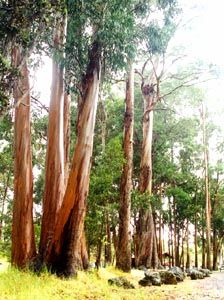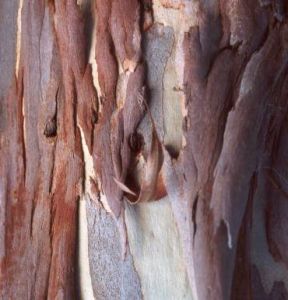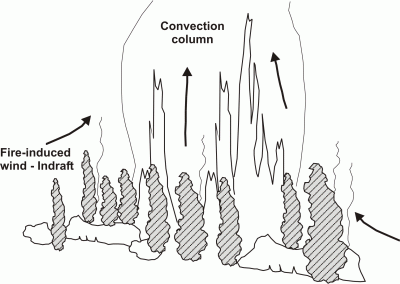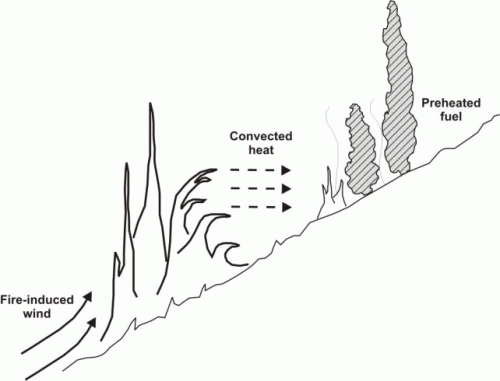
| ||||||||
|
|
||||||||
Fire BehaviourThe three main influences to the behaviour of fire are the characteristics of the fuel being burned, the weather, and the topography. Among these, fuel, moisture, wind speed and direction, and slope steepness seem to have the greatest effect. Fuel characteristics Fuels can come in many different forms. Some are gases, like methane and propane. Some are liquids like petrol and diesel. And some are solids like wood and coal. Fuel can be defined as any dead or living material that burns. In the case of wildfires, fire managers divide fuels into ground, surface, and aerial fuels. Ground fuels include decayed organic matter or humus, below the surface litter layer on the forest floor, as well as buried wood and roots. Surface fuels comprise dead logs, stumps, dead branches, shrubs, and dead needles, leaves, twigs, bark, and cones, all of which can be grouped as surface litter. Aerial fuels include the tree and shrub canopy higher than 1–2 metres above the forest floor. Fuel size Ignition is facilitated by a large surface area to volume ratio of fuel elements. Fuel that is smaller and finely divided (a high surface area to volume ratio), such as grass, leaves, bark etc constitute the most flammable proportion of fuel available as less heat is required to pyrolize the material. Large fuel materials, such as tree trunks and large logs are harder to ignite and therefore do not constitute a readily available source of fuel in wildfires. However, if a large enough fire with sufficient energy is started, high moisture content and low surface area to volume ratios can be overcome, and large fuel can burn rapidly. Fuel arrangement The arrangement of fuel in three dimensional space greatly affect the supply of oxygen and therefore the ease with which a fuel may be burnt (Chapman, 1994). Arrangement is based on the spacing of fuel particles, regardless of size. For example, a house in the framing stage of construction will ignite more readily and burn faster than a stack of lumber, even though it is fundamentally the same fuel. In a wildfire situation, very compact fuels such as peat will burn slowly, even when dry, compared to a similar amount of combustible material in the form of loosely packed surface litter, or stringy Eucalyptus bark (Fig. 3). Also important to wildfire behaviour is the continuity or grouping of fuel over the prescribed area. This may refer to vertical continuity, horizontal, or both. An example of this is the laddering of fuels in a forest. Grass spreads fire upwards into brush and then into the tree crowns. Any breaks in fuels tend to stop a fire with rock outcrops, bare areas, streams, meadows and lakes, interrupting the horizontal continuity of the fuel.
Figure 3. The Eucalyptus tree. Note the ‘stringy’ nature of the Eucalyptus bark. This material tends to accumulate around the base of the tree, on the forest floor, accelerating wildfire spread. (photographs courtesy of: www.mooseyscountrygarden.com).
Fuel quantity The amount of flammable material that surrounds a fire is referred to as the fuel load. The fuel load determines how vigorously a fire will burn. The gross accumulation rates of forest fuels vary from 1 to 10 tonnes per hectare per year, but net accumulation depends on the balance between the production of new fuel elements (or new biomass), which is dependant on climate, and the decomposition of surface litter, which is dependant on the population of microfauna and fungi, as well as climate (in particular, the microclimate of the litter bed) (Chapman, 1994). Varying amounts of fuel load cause the main differences in fire behaviour among fuel types. If an area contains a huge amount of large fuels, a wildfire will not burn unless there is a sufficient amount of dry fine fuel to carry the fire. The fuel load is measured by the amount of available combustible fuel per unit area, usually tonnes per hectare. Fuel moisture content The moisture content is the amount of moisture contained in a fuel, and determines the ease of ignition and spread of a wildfire. The moisture content varies in the different parts of the growing plant, as well as, with the weather and the moisture content of the substrate. The fuels involved are able to absorb moisture directly from the air. Such that, in humid or rainy weather the fuel often has too high a moisture content to burn readily and wildfires are not much of a problem. This atmospheric relative humidity is a function of the weather conditions, but also varies on a daily basis, and is at its lowest during the warmest part of the day, usually mid-afternoon, and at its highest in the early hours of the morning. For pyrolysis of a fuel to take place and burning to begin, the moisture must be turned to vapour and removed. Dead fuels burn more easily than live ones do, because they are usually drier. When the moisture content of forest fuel is above 15%, fire intensity is low, and the fire is usually controllable; 20% is the approximate upper limit for combustion. Combustion rate increases rapidly with decreasing moisture content – at 5% moisture the rate of fire spread is double that of a fuel moisture content of 7%, and at 3% moisture, another doubling occurs (Chapman, 1994). The volatile chemicals – oils and resins – in some live shrubs and trees, such as certain species of Eucalyptus and Pinus, increase the flammability of the plant fuel, with some trees exploding as soon as they are set alight. The flammability of the Eucalyptus in the Australia bush environment will be detailed further in a later section. Fuel energy content The measure of heat released by forest fuel is called the heat of combustion, and this is the maximum heat that could be released by a dry fuel if it were completely burnt (Chapman, 1994). The heat of combustion of average forest fuel is in the order of 20 000 kilojoules per kilogram, however, the moisture content of the fuel and incomplete combustion (characterised by smoke and other byproducts) affect the actual yield of heat from natural forest systems. As fuels change over time so does their flammability, which varies with their stage of growth and with differences in weather and snowpack. In some years a particularly dry summer following a wet spring can cause a bad fire season because grasses will grow tall before they dry out (Fuller, 1991). These changes in fuel flammability over time are termed the fuel cycle. Wind Wind is one of the dominant factors affecting fire behaviour. It is also the most unpredictable factor. Wind has the effect of driving flames into unburnt fuel, increasing preheating via radiation, and supplying additional oxygen, but also carries burning embers ahead of the flaming front, accelerating fire spread and starting spot fires (Chapman, 1994). Spotting occurs when the hot air rising from the fire carries embers or firebrands (pieces of burning wood) upward and over to stands of trees ahead of the fire, where they initiate new fires. Long-range spotting of Eucalyptus bark is known to have travelled some 30 km from source in the 1983 Tasmanian wildfires (Chapman, 1994). Blowing wind also serves as a fuel drying source in moist areas. Although wind is to some extent independent of both topography and the existence of fire, it is also partially dependent on both factors. For example, there may be a prevailing wind coming from the west at the time of the fire. As the air currents intercept hills, valleys, and broken terrain, deflections occur, independent of topographic features. Thus, it is not sufficient to consider prevailing wind direction as determinative of the direction of movement of a fire at a particular time or place. In hilly and broken terrain, it is not uncommon to find that the fire has progressed in a number of different directions. Not only does wind itself affect how a fire develops, fires themselves are capable of developing their own wind patterns. The heat from the fire causes the rapid rise of combustion gases (in the form of a convection column) and the heated air in the vicinity. This produces a partial vacuum which causes air to flow into the base of the fire – known as an indraft - an invariable result of every fire (Fig. 4).
Figure 4. The formation of a convection column.
Terrain/Topography The topography of a landscape affects the spread of wildfires. Of the many changing combinations of factors that determine how a fire behaves, the given terrain may be the only parameter that remains constant, and can therefore aid in the prediction of wildfire behaviour. The topography, or physical shape and features of a region refers to slope angle, slope direction and its exposure to sunlight, and also elevation. Slope angle The biggest influence on wildfire behaviour is the slope steepness. Because warm air rises, preheating uphill fuels, fires advance uphill faster than they travel downhill (Fuller, 1991). Since on a steep slope fuel ahead of the fire is exposed to significant radiative and convective heat, by the time a slope of approximately 25º is reached, the fire is virtually a sheet of flame parallel to the ground surface itself. Compared to conditions on level ground, fire velocity approximately doubles on a slope of 10º and further quadruples on a slope of 20º (Chapman, 1994). Furthermore, fires that begin uphill may deposit burning material that rolls downslope, allowing fires to begin and spread downhill. Conversely, once a fire has reached the top of a hill, it must struggle to come back down as it is not able to preheat downhill fuel to the same extent as uphill heat transfer processes allow (Fig. 5)
Figure 5. The influence of slope on wildfire behaviour.
Another important aspect of wildfire behaviour is slope direction (or slope aspect). The direction of slope determines how much sunlight it receives. This variation in sunlight and wind conditions means that all slopes have different microclimates, supporting different species of vegetation (each having different moisture levels). Slopes receiving more sunlight often have a longer fire season, a longer daily burn period, and therefore a greater number of fires during each fire season. Elevation Elevation also impacts how much wind and moisture an area receives. High elevations generally have a colder and wetter climate, and therefore often a shorter fire season. Other topographical features, such as canyons, boulders and rockslides, bodies of water, highways, and bare land, also influence fire spread. For example, fire starting at the bottom of a slope is likely to become large because more fuels are situated above it. Furthermore, in canyoned areas where two or more canyons converge, resultant wind eddies can cause fire to spread very unpredictably. Weather Short-term weather and long-term climatic changes profoundly affect a fire’s behaviour. Certain weather components, such as drought, temperature, humidity, air instability, and wind speed and direction, directly affect the way that fires burn. “Bushfire weather” is that special short-term cycle within the overall climatic cycle which makes a mild fire flare up into a wildfire. The climate of each geographical region determines the fuel (vegetation) types and the length of the fire season or the time of the year when most fires occur. Weather characteristics typical of wildfire weather will be discussed below. Drought Fatality fires often are associated with abrupt weather changes that surprise fire-fighters. Large wildfires commonly occur after prolonged periods of drought, as we see in southeastern Australia. Consequently, weather observation and measurements are most important to the understanding and prediction of fire behaviour. Unlike discrete events like a wildfire, drought approaches quietly, often under the guise of sunny weather. Meteorologists define drought as simply a shortage of water, usually associated with a deficiency of rainfall, often unpredictable and unanticipated until we are in its midst. Often in a wildfire community we are made aware of the magnitude of an ongoing drought only by looking backward and examining records for evidence of the lack of moisture or precipitation. What seems clear is that drought does make more fuels available for combustion, and it frequently propels fire behaviour beyond thresholds of fire-fighter control. Relative humidity Meteorologists describe air moisture with the term relative humidity. Relative humidity is the ratio (expressed as a percentage) of the amount of water vapour that is actually in the air (content) to the maximum water vapour that the air could hold at a given temperature (capacity) (Christopherson, 2000). Relative humidity varies because of evaporation, condensation, or temperature changes, all three affecting both the moisture content and the capacity of the air to hold water vapour. During a typical day, air temperature and relative humidity are inversely related – as temperature rises, relative humidity falls. Relative humidity is highest at dawn, when air temperature is lower and the capacity of the air to hold water vapour is less. Whereas, relative humidity is lowest in the late afternoon, when higher air temperatures increase the capacity of the air to hold water vapour. At low humidity, fuels dry out, therefore catching alight more easily and burning faster. Atmospheric instability Air stability, or air’s ability to resist vertical motion, influences the development of winds and depends on how fast the air cools with elevation. It simply means that air tends to move up and down until it reaches air its own temperature. Above the Earth’s surface the various layers of air may have different degrees of stability and instability. Atmospheric instability causes high-reaching flames, crown fires and long spotting distances and can usually be detected because of accompanying gusty winds which make bushfire behaviour hard to predict and control. In calmer weather a layer of stable air inhibits the rising of warm air in convection currents, as though there were a lid on the atmosphere, producing more uniform burning conditions. Forecasts of low-level stability, inversion layers, or unstable conditions can be obtained from fire-weather forecasters. Local indicators of stability at the fire site are steady winds, clouds in layers, and poor visibility due to haze and smoke hanging near the ground. Unstable conditions are indicated by gusty winds, good visibility, and clouds with vertical growth.
|
||||||||
| ||||||||



